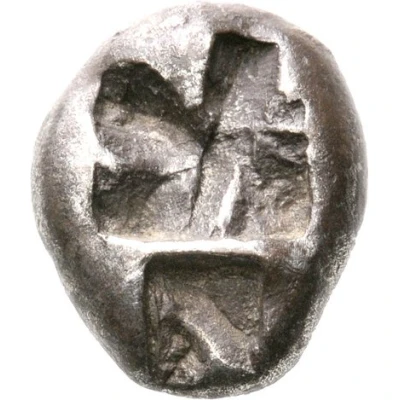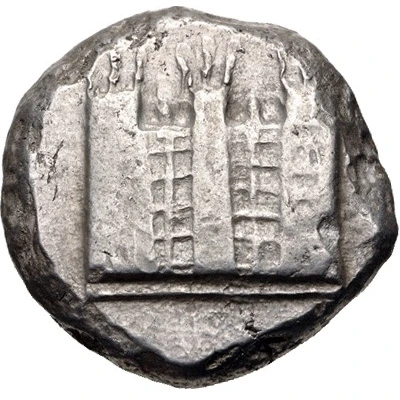


© Classical Numismatic Group, Inc.
Stater 525 BC - 475 BC
| Silver | 9.71 g | 17.5 mm |
| Issuer | Uncertain Greek city (Greece (ancient)) |
|---|---|
| Type | Standard circulation coin |
| Years | 525 BC - 475 BC |
| Value | 1 Stater = 3 Drachm |
| Composition | Silver |
| Weight | 9.71 g |
| Diameter | 17.5 mm |
| Shape | Round (irregular) |
| Technique | Hammered, Incuse |
| Demonetized | Yes |
| Updated | 2024-10-10 |
| Numista | N#155957 |
|---|---|
| Rarity index | 100% |
Reverse
Herakles, wearing lion skin headdress, holding bow in extended right hand and club raised overhead in left, advancing left. Uncertain devices above, to right, forepart of creature left, head reverted and all within incuse square with portions of the sides extending into the inner fields
Comment
Note from CNG:This stunning issue was first discovered in a small group of coins found circa 1970 that M.J. Price and N. Waggoner thought was likely another parcel from the Asyut Hoard. The authors suggested the coin was from the Cypriot mint of Lapethos based on an issue of that mint that has roughly similar types (cf. Larnaca Hoard 458-30). The coin was further analyzed by O. Masson in his RN 1982 article, "Notes de numismatique Chypriote" (pp. 14–6), in which he accepted Price and Troxell's attribution, and suggested that the epigraphy referred to a king named 'B[D]– (or 'abd–), for which there are possibilities at various locations on Cyprus. Price and Waggoner had found the inscription "vague", but suggested that it was perhaps Baal written in retrograde. The coin was again discussed by J.H. Kagan in the context of discussing a hoard of archaic coins that included two staters with a nearly identical obverse type as here, but lacking any legend and paired with a reverse featuring the forepart of a winged, man-headed bull right in an incuse (J.H. Kagan, "An Archaic Greek coin hoard from the Eastern Mediterranean and early Cypriot coinage" in NC 154 [1994], pp. 17–52, at 36 [Kagan also notes that one of these winged-bull staters was present in the archaic Demanhur Hoard (IGCH 1637)]). Kagan accepted an attribution to an uncertain mint on Cyprus, though he was not convinced of the connection to the Lapethos issues noted by Price and Waggoner. Two fractions, a third and a sixth stater, have since come to light that must be associated with the present coin, both featuring obverses with the exact same type as here, but with rough incuse squares on their reverse (see references above). While no legend is visible on the third stater, the sixth stater appears to have the Aramaic letters B' above, and another B' in the left field, flanking the lower wing (though the second letter is partially off the flan).
The attribution of these issues to a mint on Cyprus, though, is untenable for many reasons. First, the association of the issue with the Lapethos coins is very weak. The obverses are certainly of very different figures, though their poses are somewhat similar. The reverse type is found on many coinages elsewhere – a popular type that was replicated on a number of disparate issues. Second, none of the known provenances for any of these coins is a location on Cyprus – two are in Egypt, Asyut and Demanhur, while the third is thought to be from a site in Cilicia, Syria, or Phoenicia. Third, all of these hoards contained coins from various mints, and none are of exclusively Cypriot composition. Fourth, characteristics of the flan – thick and compact in manufacture – is rather inconsistent with early Cypriot issues. The coins of Euelthon are the most similar, but even these have flans that are consistently more flat and spread. In contrast, many early coins of southern Asia Minor, Syria, and Phoenicia have this type of flan. Fifth, the form of the incuse, with portions of the sides of the square extending into the fields, is not present on any Cypriot issues, but is known on coins of Lycia (cf. Asyut 249–51) and an uncertain mint likely in southern Asia Minor or Syria (cf. Triton XXI, lot 515, and Savoca 19, lot 96). As such, it seems more likely that this coin is an issue from southern Asia Minor, particularly so if the issues with the forepart of a winged, man-headed bull are from the same series, as that reverse type is well known on issues in Caria, Lycia, and Cilicia.
Finally, the identification of the types has also probably been incorrect. The figure on the obverse has traditionally been identified as a Gorgon, which would make this issue unique for the fact that it would be the only Greek issue depicting the full figure of a Gorgon, rather than just its head. Admittedly, the facing head with its protruding tongue is identical to the form of Gorgon heads commonly found on early coins, but other characteristics of the figure suggest it is not a Gorgon. For one, the figure has four straight wings, depicted in a style that is the norm for eastern deities, but is unknown for Gorgons. There are rare early vases that do depict Medusa with four wings, but they are quite different in their representation (cf. Attic black figure amphora Paris N1020 or F230, in the Louvre). The most salient feature discounting the figure as a Gorgon has been completely overlooked before – the figure has a tail – a feature that is not a part of any ancient representation of a Gorgon, nor is a Gorgon ever described as having one in ancient literature. It is thus more likely that the obverse depicts a local representation of Ba'al, as noted by the legend on the coins. If this is correct, it is also likely that the reverse type does not depict Herakles, as previously described, but the eastern deity associated with him, Melkart.
Interesting fact
One interesting fact about this coin is that it features an early depiction of a mythical creature, possibly a griffin or a sphinx, on its obverse side. This suggests that the coin was influenced by ancient Mesopotamian and Persian mythology, which often featured such creatures in their art and symbolism. This coin's design may have been a way for the ancient Greek city-state to showcase its cultural connections and trade relationships with other civilizations of the time.



